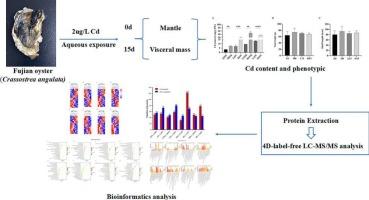Comparative proteomic analysis of Fujian oyster (Crassostrea angulata) with different cadmium accumulation capabilities
IF 2.2
2区 生物学
Q4 BIOCHEMISTRY & MOLECULAR BIOLOGY
Comparative Biochemistry and Physiology D-Genomics & Proteomics
Pub Date : 2025-07-22
DOI:10.1016/j.cbd.2025.101581
引用次数: 0
Abstract
Cadmium (Cd) can be transmitted by the food chain and biomagnification, leading serious health risks to humans. It is a major metal pollutant in marine environments. Oysters, being the most widely farmed shellfish globally, have an exceptional ability to accumulate and tolerate Cd. Research has shown that there are significant individual differences in the ability of oysters to accumulate Cd, although their potential molecular basis and key regulatory mechanisms are still unclear. This study utilized 4D-label-free quantitative proteomics to compare individuals within the same Fujian oyster population exhibiting significant difference in Cd accumulation (2–5 times higher or lower Cd levels). It identified 946 differentially expressed proteins (DEPs) totally. Calcium-binding proteins such as calmodulin (CaM) and phospholipid-transporting ATPase ABCA1 were significantly upregulated in high-accumulating oysters, likely providing more cellular binding sites for Cd and enhancing its sequestration, thereby increasing Cd accumulation in oyster tissues. Glutathione S-transferases (GSTs) and heat shock 70 kDa protein 12A (Hspa12a) play key roles in Cd detoxification and cellular antioxidant defense, particularly in oysters with low Cd accumulation. Thus, the varying expression of proteins related to Cd sequestration and detoxification is a crucial factor underlying the variability in Cd accumulation capacity among Fujian oysters. This study illuminates how oysters exhibit differential Cd accumulation at a molecular level. Monitoring marine environmental pollution and guaranteeing the safety of seafood will likewise be crucial.

不同镉积累能力福建牡蛎的比较蛋白质组学分析
镉(Cd)可以通过食物链和生物放大传播,给人类带来严重的健康风险。它是海洋环境中的主要金属污染物。牡蛎是全球最广泛养殖的贝类,具有非凡的积累和耐受Cd的能力。研究表明,牡蛎积累Cd的能力存在显著的个体差异,尽管其潜在的分子基础和关键调控机制尚不清楚。本研究利用无4d标记的定量蛋白质组学方法比较了福建同一牡蛎种群中Cd积累差异显著(Cd水平高2-5倍或低2-5倍)的个体。共鉴定出946个差异表达蛋白(dep)。钙结合蛋白如钙调蛋白(calmodulin, CaM)和磷脂转运atp酶ABCA1在高蓄积牡蛎中显著上调,可能为Cd提供了更多的细胞结合位点并增强了Cd的固存,从而增加了Cd在牡蛎组织中的蓄积。谷胱甘肽s -转移酶(GSTs)和热休克70 kDa蛋白12A (Hspa12a)在Cd解毒和细胞抗氧化防御中起关键作用,特别是在低Cd积累的牡蛎中。因此,与Cd隔离和解毒相关的蛋白质的不同表达是福建牡蛎Cd积累能力变化的关键因素。这项研究阐明了牡蛎如何在分子水平上表现出不同的Cd积累。监测海洋环境污染和保证海产品安全同样至关重要。
本文章由计算机程序翻译,如有差异,请以英文原文为准。
求助全文
约1分钟内获得全文
求助全文
来源期刊
CiteScore
5.10
自引率
3.30%
发文量
69
审稿时长
33 days
期刊介绍:
Comparative Biochemistry & Physiology (CBP) publishes papers in comparative, environmental and evolutionary physiology.
Part D: Genomics and Proteomics (CBPD), focuses on “omics” approaches to physiology, including comparative and functional genomics, metagenomics, transcriptomics, proteomics, metabolomics, and lipidomics. Most studies employ “omics” and/or system biology to test specific hypotheses about molecular and biochemical mechanisms underlying physiological responses to the environment. We encourage papers that address fundamental questions in comparative physiology and biochemistry rather than studies with a focus that is purely technical, methodological or descriptive in nature.

 求助内容:
求助内容: 应助结果提醒方式:
应助结果提醒方式:


